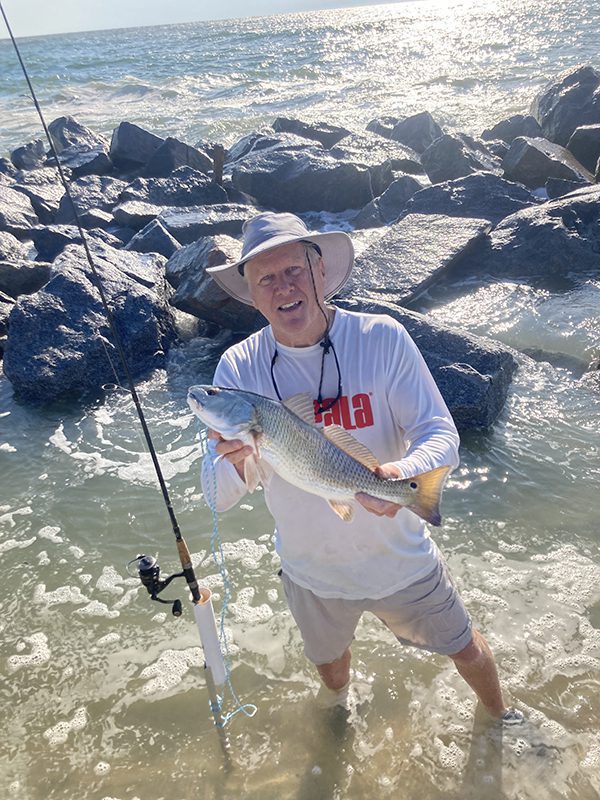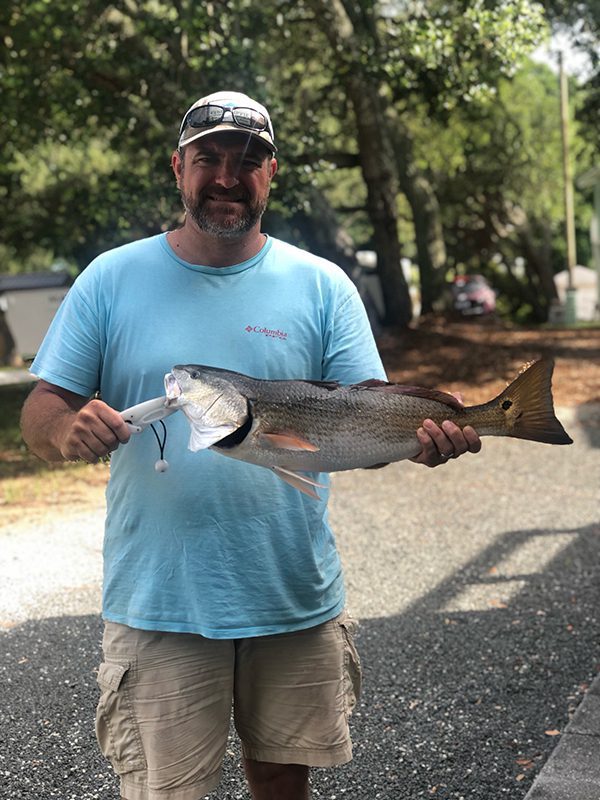North Myrtle Beach/Little River – September 2022
Patrick, of Captain Smiley Fishing Charters, reports that anglers fishing in the ICW and up in mainland creeks have been seeing some good action on the lower and incoming tide cycles.
Black drum action really turned on with the slight cooling in water temperature. Anglers have been catching plenty of slot-sized fish, with a couple mixed in giants (to 40”+), on bottom rigged live or cut shrimp.
Speckled trout and red drum have been feeding well on live shrimp and live finger mullet. The summertime patterns have both species pretty scattered throughout the inshore waters.
Anglers fishing at the jetties have been catching a few citation-class red drum while bottom fishing with live menhaden. These same bottom rigs with big live baits have also generated some shark action.
Floating live shrimp along the rocks has produced some speckled trout.
Anglers fishing South Carolina waters have been having a lot of flounder success fishing Caudle Reef and similar nearshore structures. Anglers fishing both states have had success with smaller live menhaden, live finger mullet, or live mud minnows when targeting the flatfish.
The nearshore bite has picked up a little with the slightly cooler temperatures. Both spanish mackerel and bluefish are hanging around from the beach out to nearshore reefs.
The local piers have started to land a few king mackerel.

Stan Ryba hooked this 22.5″ redfish on live finger mullet at the Murrells Inlet jetty.
Bob, of Strange Magic Fishing Charters, reports flounder are still the main star, with action being red hot. Live shrimp, minnows, or soft plastics are all getting strikes. On the lower tides, it is best to target holes in the backwaters, and on higher tides, focus on creek mouths and ICW channel openings.
Using the same baits under a popping cork in these areas also opens up the opportunity of speckled trout and red drum action.
Live or fresh dead shrimp are coaxing black drum to strike in the Tilghman docks area, as well as around other deeper docks along the ICW. Look for shell banks near these hard structures for great areas to target the black drum.
Anglers fishing at the jetties are catching flounder using live baits and soft plastics on heavier jig heads. The bite has seemed best when positioned outside the jetties on an incoming tide, and then moving inside on the falling.
Chris, of Fine Catch Fishing Charters, reports that there has been a good spanish mackerel and flounder bite out on the nearshore reefs. The flatfish have been hitting Carolina-rigged mullet, menhaden, and baby croakers (3-7” range). The key has been to get baits up tight to structure at these ARs.
Spanish mackerel have been hitting both trolled mackerel trees behind #1 sized planers and silver or gold casting spoons thrown into surface-feeding activity. You can also chum these schools up with live mullet and then drop down a free-lined bait. Live baits have produced some of the larger fish.
Anglers fishing out at the jetties are finding action on trout, redfish, flounder, and spanish mackerel.
Most of the speckled trout are being caught on live shrimp rigged 5-10’ under corks and drifted down the rocks. This same tactic will also produce some redfish.
There are a few bull reds around being caught on larger Carolina rig setups (2-3 oz. weight and 8/0 hook). Cut bait (whether it’s bluefish, pogies, or mullet) or live pogies have produced most of the bites.
In the backwaters, red drum are starting to spread out a little and chase bait. Anglers will do best by focusing on the areas where large schools of bait run, such as grass edges, ICW docks, oyster mounds, shallow mud flats, and creek mouth corners. Live bait works great, but you can also find action with Gulp shrimp, topwater plugs, or Vudu shrimp.
Some of these same areas will also be producing scattered speckled trout and flounder.
Most trout action inside has been in the larger mainland creeks, and slip cork rigs with live shrimp (or even mullet) can entice a strike.
Black drum are staged up in deeper channels (especially those with structure) and feeding on live or fresh dead shrimp. Fiddler crabs also work well when the undesirable bait-stealers (pinfish/croakers) are active.
Flounder are just about everywhere from creek mouths and out into the deeper holes along the ICW. Live bait is great for the flatfish, as is Gulp shrimp or Vudu shrimp fished with more weight (1/4-3/8 oz.) to ensure baits stay on the bottom.
Bevan, of Chilly Water Fishing, reports that bottom fishing remains strong, with great catches of vermilion snapper and black sea bass at structure in the 75-90’ range.
Pushing out to the 100-120’ range will also add triggerfish to the targeted species.
Grouper fishing has picked up, and anglers should start looking for this action over ledges, wrecks, and rocks in the 90-125’ range. Jigging up some live bait from offshore areas will help the chance of grouper bites.
Larry, of Voyager Fishing Charters, reports that offshore bottom fishing in the 110’+ range remains spectacular, as anglers are glad to be returning with full mixed bags of triggerfish, porgies, amberjack, grouper, grunts, and vermilion snapper.
A few king mackerel have been caught while running a free-lined bait.
Bottom fishing closer to the beach (less than 10 miles) has produced good numbers of black sea bass and porgies.
Schools of spanish mackerel have been moving back into the area just outside Little River, and king mackerel are holding deep in the 30-40 mile range.

Ellery Myrick, of Seagrove, hooked this 26.75″ red drum on a Carolina-rigged finger mullet in the ICW at Holden Beach.
Andrea, of Cherry Grove Pier, reports that anglers have been finding a few speckled trout while getting out on the planks early in the morning.
Some good-sized flounder are mixed in the bottom action for those rigged with live baits, and anglers have seen an uptick in bottom fishing action with both good-sized croakers and a few sea mullet being caught.
Richard, of Apache Pier, reports that anglers are catching mixed bags of whiting, croaker, and some keeper flounder.
King mackerel are starting to be seen and hooked.
